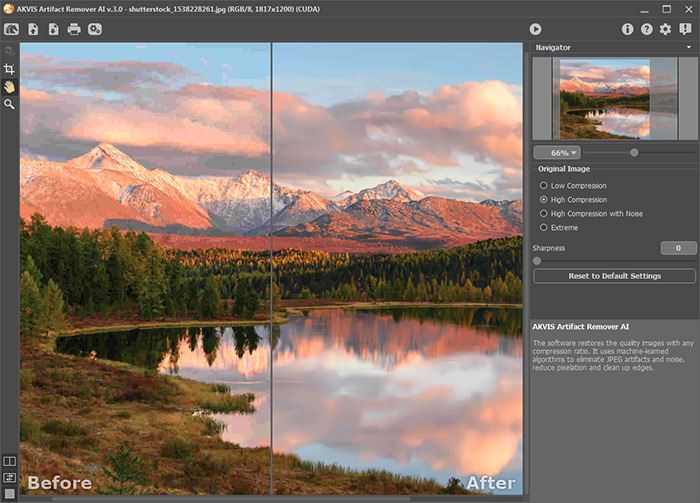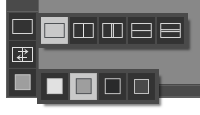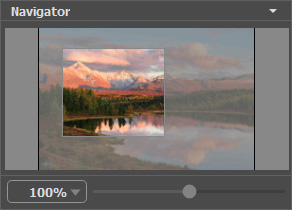Workspace
AKVIS Artifact Remover AI can work independently as a standalone program as well as a plugin to a photo editor.
Standalone is an independent program. You can run it in the usual way.
Plugin is an additional module for Photoshop and other compatible image editors. To call the plugin, select AKVIS –> Artifact Remover AI from filters of your image editing program.
The AKVIS Artifact Remover AI workspace looks like this:

The left part of the program's window is taken by the Image Window with two tabs - Before and After. The Before tab shows the original image, the After tab shows the result.
To switch between the tabs and compare the original and the resulting images, just click anywhere in the image.
You can select how Image Window and Before/After tabs will be shown by adjusting the Image View Modes in the bottom part of the left panel.

In the upper part of the program's window you can see the Control Panel and the following controls:
- The button
 opens the home page of AKVIS Artifact Remover AI.
opens the home page of AKVIS Artifact Remover AI.
- The button
 (only in the standalone version) opens an image for processing. The hot-keys are Ctrl+O on Windows, ⌘+O on Mac.
(only in the standalone version) opens an image for processing. The hot-keys are Ctrl+O on Windows, ⌘+O on Mac.
Right-click this button to display the list of recent files. You can change the number of recent documents in the program's Preferences.
- The button
 (only in the standalone version) saves image to the disk. The hot-keys are Ctrl+S on Windows, ⌘+S on Mac.
(only in the standalone version) saves image to the disk. The hot-keys are Ctrl+S on Windows, ⌘+S on Mac.
- The button
 (only in the standalone version) lets you print the image. The hot-keys are Ctrl+P on Windows, ⌘+P on Mac.
(only in the standalone version) lets you print the image. The hot-keys are Ctrl+P on Windows, ⌘+P on Mac.
- The button
 (only in the standalone version) opens the Batch Processing dialog to automatically process a series of images.
(only in the standalone version) opens the Batch Processing dialog to automatically process a series of images.
- The button
 starts image processing of the entire image. The result is shown in the After tab.
starts image processing of the entire image. The result is shown in the After tab.
- The button
 (only in the plugin version) applies the result to the image and closes the plugin.
(only in the plugin version) applies the result to the image and closes the plugin.
- The button
 calls information about the program, license, and version.
calls information about the program, license, and version.
- The button
 calls the Help files. The hot-key is F1.
calls the Help files. The hot-key is F1.
- The button
 calls the Preferences dialog box.
calls the Preferences dialog box.
- The button
 opens a window showing the latest news about the program.
opens a window showing the latest news about the program.
To the left of the main window there is the Toolbar.
The button ![]() switches on/off the Preview Window.
switches on/off the Preview Window.
The button ![]() (only in the standalone version) activates the Crop tool which allows cutting off unwanted areas in the image and reducing its size.
(only in the standalone version) activates the Crop tool which allows cutting off unwanted areas in the image and reducing its size.
The button ![]() activates the Hand tool which allows you scroll the image when it does not fit within the window at the desired scale. Bring the cursor over the image, and while keeping the left mouse button pressed move in the desired direction.
activates the Hand tool which allows you scroll the image when it does not fit within the window at the desired scale. Bring the cursor over the image, and while keeping the left mouse button pressed move in the desired direction.
Double-clicking on the tool's icon ![]() makes the image fit the window.
makes the image fit the window.
The button ![]() activates the Zoom tool which changes the image's scale. To zoom in, click the image. To zoom out left click with Alt on the image. Press Z to quickly access the tool.
activates the Zoom tool which changes the image's scale. To zoom in, click the image. To zoom out left click with Alt on the image. Press Z to quickly access the tool.
Double-clicking on the tool's icon ![]() makes the image scale to 100% (actual size).
makes the image scale to 100% (actual size).
Navigate and scale the image using the Navigator. The frame in the Navigator surrounds the area of the image which is visible in the Image Window; the area outside of the frame will be shaded. The frame can be dragged, thereby changing the visible portion of the image. To move the frame, place the cursor within it, left click the mouse, and then drag.

Use the slider to scale the image in the Image Window. When you move the slider to the right, the image scale increases. When you move the slider to the left, the image scale decreases.
To scroll the image in the Image Window you can press the spacebar on the keyboard and drag the image with the left mouse button. Use the scroll wheel of the mouse to move the image up/down, by keeping the Ctrl key pressed (Mac: ⌘) – to the left/to the right, by keeping the Alt key pressed (Mac: Option) − scale the image. Right-click the scroll bar to activate the quick navigation menu.
You can also change the image scale by entering a new coefficient into the scale field and pressing the button Enter (Return in Mac). The drop-down menu shows some frequently used coefficients.
You can use hot-keys to change the image scale + and Ctrl++ (⌘++ in Mac) to increase the image scale and - and Ctrl+- (⌘+- in Mac) to reduce the scale.
Below the Navigator is the Settings Panel where you can choose the processing mode.
Under the Settings Panel you can see Hints for the parameters and buttons when you hover over them with the cursor. You can choose where the hints will be shown or hide them in the program's Preferences.
